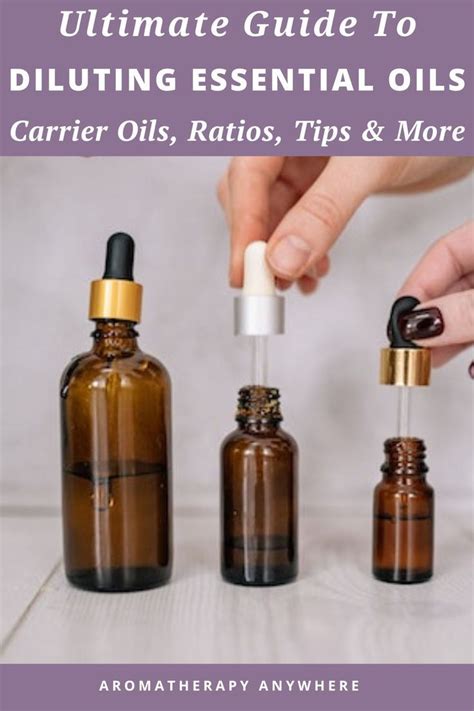Essential oils are highly concentrated plant extracts that offer a wide range of therapeutic benefits. However, they are typically too potent to be applied directly to the skin or ingested. That’s where essential oil carriers come in.

What is an Essential Oil Carrier?
An essential oil carrier is a substance that dilutes essential oils to make them safe for topical or internal use. Common carriers include vegetable oils, such as coconut, jojoba, and almond oil, as well as water, alcohol, and glycerin.
Why Use an Essential Oil Carrier?
Diluting essential oils with a carrier has several benefits:
- Safety: Pure essential oils can cause skin irritation, burns, and other adverse reactions. Diluting them reduces their potency and minimizes the risk of these reactions.
- Absorption: Carriers help essential oils penetrate the skin more effectively, enhancing their absorption and therapeutic effects.
- Extended shelf life: Essential oils mixed with a carrier can last longer, as the carrier acts as a preservative.
Choosing the Right Essential Oil Carrier
The choice of essential oil carrier depends on the intended use:
- Topical application: Vegetable oils like coconut, olive, or almond oil are suitable for topical use, as they are moisturizing and non-comedogenic (won’t clog pores).
- Inhalation: Diffusers or humidifiers use water as a carrier to disperse essential oils into the air.
- Internal use: Alcohol or glycerin are recommended carriers for ingesting essential oils, as they are easily absorbed and have a neutral taste.
How to Dilute Essential Oils
The dilution ratio varies depending on the oil’s potency and the intended use. Here’s a general guideline:
| Dilution Ratio | Use |
|---|---|
| 1-2 drops per teaspoon of carrier | Topical application, massage |
| 5-10 drops per tablespoon of carrier | Bath, foot soak, body spray |
| 15-30 drops per ounce of carrier | Roller bottles, inhalers |
| 3-5 drops per 100ml of water | Diffusers |
Safety Precautions
When using essential oils with a carrier:
- Always do a patch test before applying to a large area of skin.
- Avoid carriers that can cause allergic reactions or interact with medications you’re taking (e.g., grapefruit essential oil with certain heart medications).
- Store diluted essential oils in a cool, dark place to maintain their shelf life.
Types of Essential Oil Carriers
Vegetable Oils:
- Coconut oil: Nourishing, antibacterial, and emollient
- Jojoba oil: Absorbs quickly, non-comedogenic, and stable
- Almond oil: Rich in vitamins, minerals, and antioxidants
Water:
- Distilled water: Pure and free of impurities
- Reverse osmosis water: Removed 90-99% of impurities
Alcohol:
- Ethanol: Food-grade alcohol, suitable for ingesting
- Isopropyl alcohol: Not suitable for ingesting
Glycerin:
- Vegetable glycerin: Sweet-tasting, non-toxic, and hypoallergenic
Applications of Diluted Essential Oils
- Skin care: Moisturizers, serums, massage oils
- Hair care: Shampoos, conditioners, hair masks
- Inhalation: Diffusers, inhalers, steam baths
- Personal care: Toothpaste, deodorant, mouthwash
- Cleaning: Surface cleaners, air fresheners, laundry detergents
Tips and Tricks
- Experiment with different carriers: Explore various carriers to find the one that best suits your needs.
- Start with a low dilution ratio: Gradually increase the amount of essential oil if needed.
- Store diluted oils in amber glass bottles: Protect oils from light and air exposure.
- Label your mixtures: Keep track of the essential oil and carrier used, as well as the dilution ratio.
Pros and Cons of Essential Oil Carriers
Pros:
- Enhance safety and reduce risks
- Improve absorption and efficacy
- Extend shelf life
Cons:
- May alter the scent of the essential oil
- Some carriers may not be suitable for all skin types
- Ingesting essential oils requires careful dilution and guidance from a qualified healthcare professional
| Essential Oil | Topical Use (1-2%) | Inhalation (2-5%) | Internal Use (0.5-1%) |
|---|---|---|---|
| Lavender | 1-2 drops / 1 tsp carrier | 5-10 drops / 1 tbsp carrier | 1-2 drops / 1 oz carrier |
| Tea Tree | 1-2 drops / 1 tsp carrier | 5-10 drops / 1 tbsp carrier | 1 drop / 1 oz carrier |
| Lemon | 1-2 drops / 1 tsp carrier | 5-10 drops / 1 tbsp carrier | Not recommended for internal use |
| Peppermint | 1 drop / 1 tsp carrier | 2-5 drops / 1 tbsp carrier | 1 drop / 1 oz carrier |
| Application | Essential Oils |
|---|---|
| Relaxation | Lavender, Bergamot, Ylang-Ylang |
| Energy boost | Peppermint, Eucalyptus, Rosemary |
| Pain relief | Wintergreen, Frankincense, Myrrh |
| Immune support | Oregano, Tea Tree, Thyme |
| Vegetable Oil | Key Properties |
|---|---|
| Coconut oil | Nourishing, antibacterial, antiviral |
| Jojoba oil | Absorbs quickly, non-comedogenic, anti-inflammatory |
| Almond oil | Rich in vitamins, minerals, and antioxidants, emollient |
| Grapeseed oil | Lightweight, absorbs easily, high in antioxidants |
| Avocado oil | Rich in vitamins, minerals, and fatty acids, anti-aging |
| Use | Precautions |
|---|---|
| Topical application | Do a patch test before using on a large area of skin, avoid contact with eyes |
| Inhalation | Use a diffuser or humidifier, avoid inhaling undiluted oils |
| Internal use | Only use essential oils labeled for internal use, consult a qualified healthcare professional |
Essential oil carriers are indispensable in the safe and effective use of essential oils. They reduce risks, enhance absorption, and extend the shelf life of these powerful plant extracts. By understanding the different types of carriers, dilution ratios, and applications, you can maximize the benefits of essential oils while minimizing potential risks. Always remember to use essential oils with caution, experiment with different carriers, and seek professional guidance when necessary.
